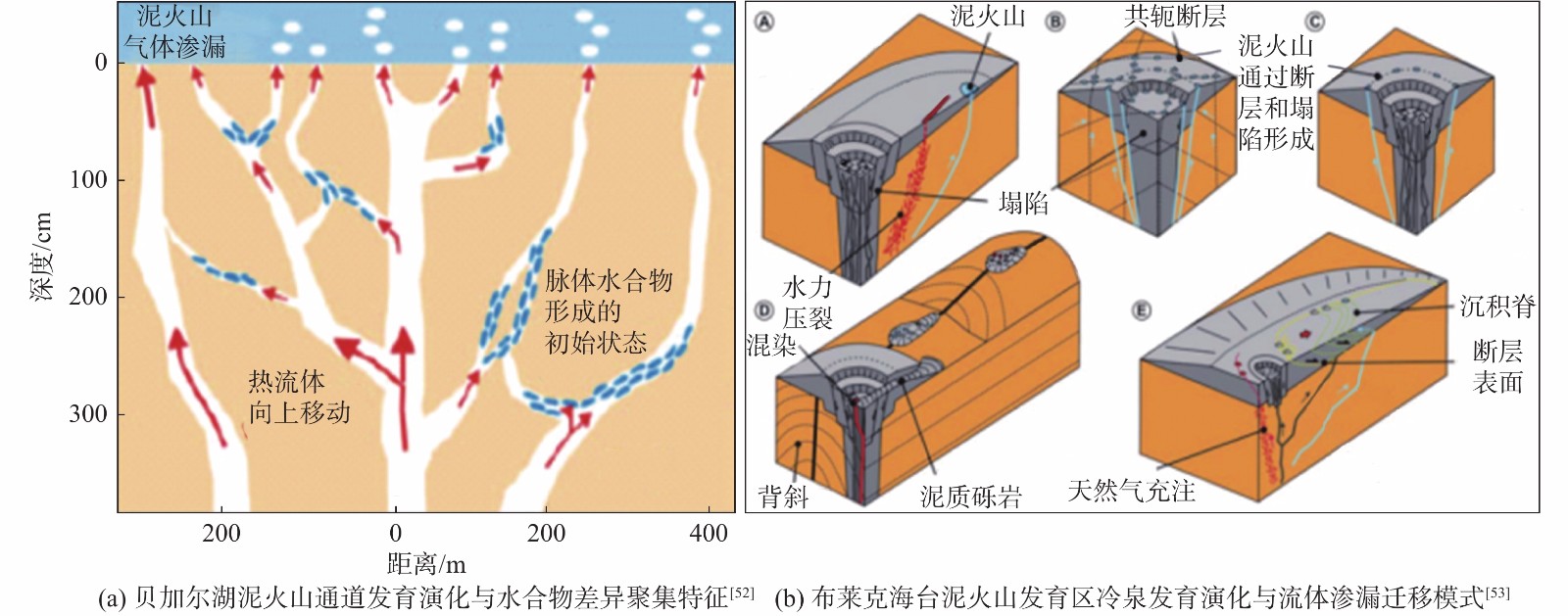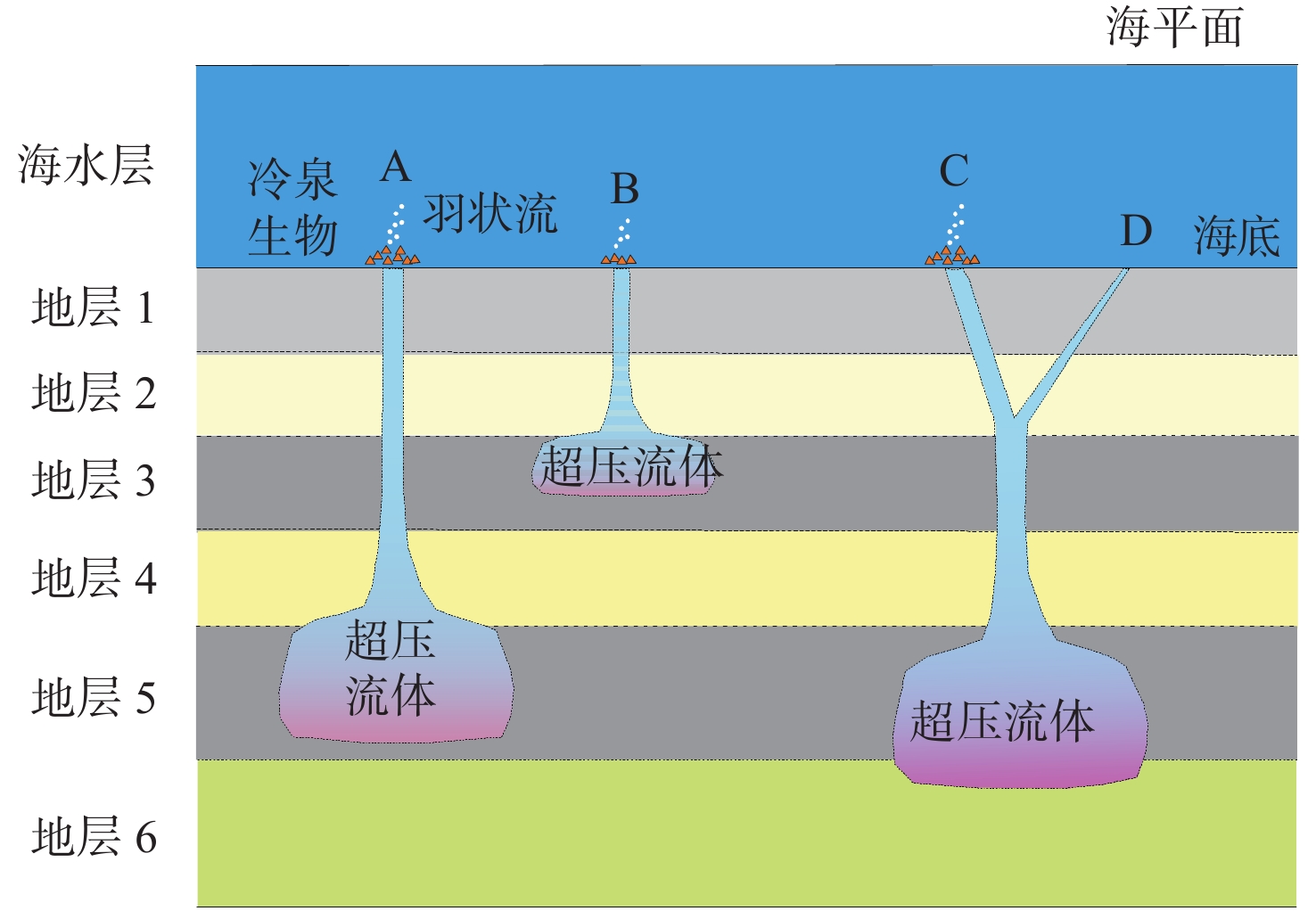HYDRODYNAMIC CHARACTERISTICS OF COLD SEEP DIFFERENTIAL DEVELOPMENT IN THE QIONGDONGNAN BASIN AND THEIR DEEP CONTROLLING MECHANISMS
-
摘要:
海底冷泉与天然气水合物资源、全球气候变化和极端环境生态系统等重大问题密切相关,具有重要的科学意义。冷泉系统形成演化影响因素众多,其时空分布、活动特征及相关物理、化学和生物作用差异较大。冷泉活动的浅表层响应与深部控制要素的耦合关系、冷泉差异发育的流体动力学过程与控制机理等科学问题有待深入研究。以琼东南盆地为主要研究对象,针对冷泉差异发育特征及其控制机理问题,以流体动力学研究为主线,深浅连通,将浅表层冷泉观测数据与深部地质环境、地层压力等要素相结合,精细刻画冷泉流体从物源层向浅表层运移的渗漏通道特征,建立冷泉浅表层响应与深部要素之间的耦合关系,揭示冷泉差异发育的流体动力学模式,探讨冷泉差异发育的控制机理,以期为冷泉环境水合物勘查与试采、深海物质和能量迁移转化及极端环境的生态系统研究提供理论依据。
Abstract:The submarine cold seeps are closely related to some important scientific issues, such as the occurrence of natural gas hydrate, global climate change, and extreme environmental ecosystems. There are many factors affecting the formation and evolution of cold seep systems. Their spatial and temporal distribution, activity characteristics, and related physical, chemical, and biological effects are very different from place to place. The coupling relationship between shallow surface cold seeps activities and their deep controlling factors, the hydrodynamic process and control mechanism of differential development of cold seeps need to be further studied. This paper tries to take the Qiongdongnan Basin as the research object and select some typical cold seep active stations as cases to solve the problem of cold seep differential activity process and their control mechanisms. Based on previous researches, taken the hydrodynamic research as the key, and combined the observation data of shallow cold seeps together with the deep geological environment and formation pressure, some numerical models are set up in this paper for the cold seep fluid flow and energy conversion process. The dynamics process of fluid migration from deep to shallow are portrayed. And analyzed are also the geological conditions and control factors for different cold seep systems. Afterward, the coupling relationship between the shallow surface responses of cold seeps to the deep elements is identified. Then a dynamic model of cold seep differential development is established. In the end, the control mechanisms of cold seep differentiation are discussed. This work may provide a theoretical basis for hydrate exploration and trial mining, study of deep-sea material and energy migration and transformation, and research of the extreme environmental ecosystem of cold seep.
-
Key words:
- submarine cold seep /
- differential development /
- hydrodynamics /
- control mechanism /
- Qiongdongnan Basin
-

-
图 2 琼东南盆地泥底辟、气烟囱差异发育与水合物运聚模式[34]
Figure 2.
-
[1] 陈多福,陈先沛,陈光谦. 冷泉流体沉积碳酸盐岩的地质地球化学特征[J]. 沉积学报,2002,20(1):34-40. doi: 10.3969/j.issn.1000-0550.2002.01.007
[2] ROBERTS H H,AHARON P. Hydrocarbon-derived carbonate buildups of the northern Gulf of Mexico continental slope:a review of submersible investigations[J]. Geo-Marine Letters,1994,14(2/3):135-148.
[3] BOETIUS A,WENZHÖFER F. Seafloor oxygen consumption fuelled by methane from cold seeps[J]. Nature Geoscience,2013,6(9):725-734. doi: 10.1038/ngeo1926
[4] SUESS E. Marine cold seeps and their manifestations:geological control,biogeochemical criteria and environmental conditions[J]. International Journal of Earth Sciences,2014,103(7):1889-1916. doi: 10.1007/s00531-014-1010-0
[5] PAULL C K,HECKER B,COMMEAU R,et al. Biological communities at the Florida Escarpment resemble hydrothermal vent taxa[J]. Science,1984,226(4677):965-967. doi: 10.1126/science.226.4677.965
[6] SUESS E. Marine cold seeps: background and recent advances[M]//Wilkes H. Hydrocarbons, oils and lipids: diversity, origin, chemistry and fate. Springer International Publishing, 2018.
[7] FENG D,QIU J W,HU Y,et al. Cold seep systems in the South China Sea:an overview[J]. Journal of Asian Earth Sciences,2018,168:3-16. doi: 10.1016/j.jseaes.2018.09.021
[8] WAN Z F,XU X,WANG X Q,et al. Geothermal analysis of boreholes in the Shenhu gas hydrate drilling area,northern South China Sea:influence of mud diapirs on hydrate occurrence[J]. Journal of Petroleum Science and Engineering,2017,158:424-432. doi: 10.1016/j.petrol.2017.08.053
[9] WAN Z F,YAO Y J,CHEN K W,et al. Characterization of mud volcanoes in the northern Zhongjiannan Basin,western South China Sea[J]. Geological Journal,2019,54(1):177-189. doi: 10.1002/gj.3168
[10] 赵斌,刘胜旋,李丽青,等. 南海冷泉分布特征及油气地质意义[J]. 海洋地质前沿,2018,34(10):32-43.
[11] 吴能友,孙治雷,卢建国,等. 冲绳海槽海底冷泉-热液系统相互作用[J]. 海洋地质与第四纪地质,2019,39(5):23-35.
[12] 冯东,宫尚桂. 海底冷泉系统硫的生物地球化学过程及其沉积记录研究进展[J]. 矿物岩石地球化学通报,2019,38(6):1047-1056.
[13] MAZURENKO L L,SOLOVIEV V A. Worldwide distribution of deep-water fluid venting and potential occurrences of gas hydrate accumulations[J]. Geo-Marine Letters,2003,23(3/4):162-176.
[14] TALUKDER A R. Review of submarine cold seep plumbing systems:leakage to seepage and venting[J]. Terra Nova,2012,24(4):255-272. doi: 10.1111/j.1365-3121.2012.01066.x
[15] GINSBURG G D, IVANOV V L, SOLOVIEV V A. Natural gas hydrates of the world’s oceans[C]//Oil and gas content of the world’s oceans. PGO Sevmorgeologia, 1984: 141-158.
[16] MILKOV A V. Worldwide distribution of submarine mud volcanoes and associated gas hydrates[J]. Marine Geology,2000,167(1/2):29-42.
[17] PENG X,GUO Z,CHEN S,et al. Formation of carbonate pipes in the northern Okinawa Trough linked to strong sulfate exhaustion and iron supply[J]. Geochimica et Cosmochimica Acta,2017,205(1):1-13.
[18] LUO M,DALE A W,WALLMANN K,et al. Estimating the time of pockmark formation in the SW Xisha Uplift (South China Sea) using reaction-transport modeling[J]. Marine Geology,2015,364:21-31. doi: 10.1016/j.margeo.2015.03.006
[19] GUAN H X,BIRGEL D,PECKMANN J,et al. Lipid biomarker patterns of authigenic carbonates reveal fluid composition and seepage intensity at Haima cold seeps,South China Sea[J]. Journal of Asian Earth Sciences,2018,168:163-172. doi: 10.1016/j.jseaes.2018.04.035
[20] 曹运诚,苏正,陈多福. 孔隙水渗流通量对渗漏型天然气水合物影响的数值模拟研究[J]. 中国科学:地球科学,2013,43(3):379-390.
[21] 韩喜球,杨克红,黄永样. 南海东沙东北冷泉流体的来源和性质:来自烟囱状冷泉碳酸盐岩的证据[J]. 科学通报,2013,58(19):1865-1873.
[22] 邬黛黛,杨飞,黄霞,等. 南海东沙海域冷泉渗漏区沉积物稀土元素地球化学特征[J]. 海洋地质与第四纪地质,2017,37(5):69-69.
[23] 薛云松,黄俊华. 冷泉沉积研究进展及环境意义[J]. 地质科技情报,2016,35(3):97-104.
[24] 杨克红,初凤友,赵建如,等. 南海北部烟囱状冷泉碳酸盐岩的沉积环境分析[J]. 海洋学报(中文版),2013,35(2):82-89.
[25] FISCHER D,MOGOLLÓN J,STRASSER M,et al. Subduction zone earthquake as potential trigger of submarine hydrocarbon seepage[J]. Nature Geoscience,2013,6(8):647-651. doi: 10.1038/ngeo1886
[26] FESEKER T,BOETIUS A,FER F W,et al. Eruption of a deep-sea mud volcano triggers rapid sediment movement[J]. Nature Communications,2014,5(1):544-559.
[27] DAVIS P. Triggered mud eruption?[J]. Nature Geoscience,2013,6(8):592-593. doi: 10.1038/ngeo1899
[28] LUPI M,SAENGER E H,FUCHS F,et al. Lusi mud eruption triggered by geometric focusing of seismic waves[J]. Nature Geoscience,2013,6(8):642-646. doi: 10.1038/ngeo1884
[29] ZHONG S L,WAN Z F,DUAN B C,et al. Do earthquakes trigger mud volcanoes? a case study from the southern margin of the Junggar Basin,NW China[J]. Geological Journal,2019,54(3):1223-1237. doi: 10.1002/gj.3222
[30] 刘善琪,尹凤玲,朱伯靖,等. 冷泉形成的数值模拟研究[J]. 地球物理学报,2015,58(5):1731-1741. doi: 10.6038/cjg20150523
[31] SUN Q L,WU S G,HOVLAND M,et al. The morphologies and genesis of mega-pockmarks near the Xisha Uplift,South China Sea[J]. Marine and Petroleum Geology,2011,28(6):1146-1156. doi: 10.1016/j.marpetgeo.2011.03.003
[32] LIANG Q Y,HU Y,FENG D,et al. Authigenic carbonates from newly discovered active cold seeps on the northwestern slope of the South China Sea:constraints on fluid sources,formation environments,and seepage dynamics[J]. Deep Sea Research Part I,2017,124:31-41. doi: 10.1016/j.dsr.2017.04.015
[33] WANG J L,WU S G,KONG X,et al. Subsurface fluid flow at an active cold seep area in the Qiongdongnan Basin,northern South China Sea[J]. Journal of Asian Earth Sciences,2018,168:17-26. doi: 10.1016/j.jseaes.2018.06.001
[34] ZHANG W,LIANG J,YANG X,et al. The formation mechanism of mud diapirs and gas chimneys and their relationship with natural gas hydrates:insights from the deep-water area of Qiongdongnan Basin,northern South China Sea[J]. International Geology Review,2020,62(7/8):789-810.
[35] HU Y,LUO M,LIANG Q Y,et al. Pore fluid compositions and inferred fluid flow patterns at the Haima cold seeps from the South China Sea[J]. Marine and Petroleum Geology,2019,103:29-40. doi: 10.1016/j.marpetgeo.2019.01.007
[36] FANG Y X,WEI J G,LU H L,et al. Chemical and Structural Characteristics of Gas Hydrates from the Haima Cold Seeps in the Qiongdongnan Basin of the South China Sea[J]. Journal of Asian Earth Sciences,2019,182:103924. doi: 10.1016/j.jseaes.2019.103924
[37] Wan Z F,Chen C M,Liang J Q,et al. Hydrochemical characteristics and evolution mode of cold seeps in the Qiongdongnan Basin,South China Sea[J]. Geofluids,2020,2020(6):1-16.
[38] ZHU W L,HUANG B J,MI L J,et al. Geochemistry,origin and deep-water exploration potential of natural gases in the Pearl River Mouth and Qiongdongnan Basins,South China Sea[J]. AAPG Bulletin,2009,93:741-761. doi: 10.1306/02170908099
[39] ZHAO Z X,SUN Z,WANG Z F,et al. The high resolution sedimentary filling in Qiongdongnan Basin,Northern South China Sea[J]. Marine Geology,2015,361:11-24. doi: 10.1016/j.margeo.2015.01.002
[40] HUANG B J,TIAN H,LI X S,et al. Geochemistry,origin and accumulation of natural gases in the deepwater area of the Qiongdongnan Basin,South China Sea[J]. Marine and Petroleum Geology,2016,72:254-267. doi: 10.1016/j.marpetgeo.2016.02.007
[41] SHI X B,JIANG H Y,YANG J,et al. Models of the rapid post-rift subsidence in the eastern Qiongdongnan Basin,South China Sea:implications for the development of the deep thermal anomaly[J]. Basin Research,2017,29(3):340-362. doi: 10.1111/bre.12179
[42] 杨力,刘斌,徐梦婕,等. 南海北部琼东南海域活动冷泉特征及形成模式[J]. 地球物理学报,2018,61(7):2905-2914. doi: 10.6038/cjg2018L0374
[43] 陈江欣,宋海斌,关永贤,等. 海底冷泉的地震海洋学初探[J]. 地球物理学报,2017,60(2):604-616. doi: 10.6038/cjg20170215
[44] FENG D,CHEN D F. Authigenic carbonates from an active cold seep of the northern South China Sea:new insights into fluid sources and past seepage activity[J]. Deep Sea Research Part II,2015,122:4-83.
[45] WANG X D,LI N,FENG D,et al. Using chemical compositions of sediments to constrain methane seepage dynamics:a case study from Haima cold seeps of the South China Sea[J]. Journal of Asian Earth Sciences,2018,168:137-144. doi: 10.1016/j.jseaes.2018.11.011
[46] DIMITROV L I. Mud volcanoes-the most important pathway for degassing deeply buried sediments[J]. Earth-Science Reviews,2002,59(1/4):49-76.
[47] WANG X J,Hutchinson D R,WU S G,et al. Elevated gas hydrate saturation within silt and silty clay sediments in the Shenhu area,South China Sea[J]. Journal of Geophysical Research-Solid Earth,2011,116(B05102). doi: 10.1029/2010JB007944
[48] 苏正,刘丽华. 南海北部陆坡天然气水合物成藏特征研究进展分析[J]. 新能源进展,2020,8(1):35-41. doi: 10.3969/j.issn.2095-560X.2020.01.006
[49] 吴时国,龚跃华,米立军,等. 南海北部深水盆地油气渗漏系统及天然气水合物成藏机制研究[J]. 现代地质,2010,24(3):433-440. doi: 10.3969/j.issn.1000-8527.2010.03.003
[50] WANG S H,YAN W,CHEN Z,et al. Rare earth elements in cold seep carbonates from the southwestern Dongsha area,northern South China Sea[J]. Marine and Petroleum Geology,2014,57:482-493. doi: 10.1016/j.marpetgeo.2014.06.017
[51] 范美彤,葛璐,朱碧,等. 冷泉碳酸盐岩Sr同位素示踪研究进展[J]. 地质学报,2019,93(8):2081-2091. doi: 10.3969/j.issn.0001-5717.2019.08.017
[52] POORT J,KHLYSTOV O M,NAUDTS L,et al. Thermal anomalies associated with shallow gas hydrates in the K-2 mud volcano,Lake Baikal[J]. Geo-Marine Letters,2012,32(5/6):407-417.
[53] HORNBACH M J,RUPPEL C,VAN DOVER C L. Three-dimensional structure of fluid conduits sustaining an active deep marine cold seep[J]. Geophysical Research Letters,2007,34(5):L05601.
[54] JOHANSEN C,TODD A C,MACDONALD I R. Time series video analysis of bubble release processes at natural hydrocarbon seeps in the Northern Gulf of Mexico[J]. Marine and Petroleum Geology,2017,82:21-34. doi: 10.1016/j.marpetgeo.2017.01.014
[55] 邸鹏飞,陈庆华,陈多福. 海底冷泉渗漏气体流量原位在线测量技术研究[J]. 热带海洋学报,2012,31(5):83-87. doi: 10.3969/j.issn.1009-5470.2012.05.012
[56] LEIFER I. Seabed bubble flux estimation by calibrated video survey for a large blowout seep in the North Sea[J]. Marine and Petroleum Geology,2015,68:743-752. doi: 10.1016/j.marpetgeo.2015.08.032
[57] 秦华伟,范相会,蔡真,等. 海底冷泉区气泡流量流速的声学探测机理研究[J]. 热带海洋学报,2016,35(4):35-39. doi: 10.11978/2015112
[58] 余翼,栾锡武,刘鸿,等. 海底冷泉气泡羽流声学探测参数研究[J]. 海洋地质与第四纪地质,2019,39(2):188-199.
[59] 刘伯然,宋海斌,关永贤,等. 南海东北部陆坡冷泉系统的浅地层剖面特征与分析[J]. 地球物理学报,2015,58(1):247-256. doi: 10.6038/cjg20150122
[60] 李灿苹,刘学伟,勾丽敏,等. 冷泉活动区天然气水合物上覆水体中气泡羽状流的数值模拟[J]. 中国科学:地球科学,2013,43(3):391-399.
[61] ZOPOROWSKI A,MILLER S A. Modelling eruption cycles and decay of mud volcanoes[J]. Marine and Petroleum Geology,2009,26(9):1879-1887. doi: 10.1016/j.marpetgeo.2009.03.003
[62] XING J H,SPIESS V. Shallow gas transport and reservoirs in the vicinity of deeply rooted mud volcanoes in the central Black Sea[J]. Marine Geology,2015,369:67-78. doi: 10.1016/j.margeo.2015.08.005
[63] VONA A,GIORDANO G,DE BENEDETTI A A,et al. Ascent velocity and dynamics of the Fiumicino mud eruption,Rome,Italy[J]. Geophysical Research Letters,2015,42(15):6244-6252. doi: 10.1002/2015GL064571
[64] HUBBERT M K,RUBEY W W. Mechanics of fluid filled porous solids and its application to over thrust faulting,role of fluid pressure in mechanics of over thrust faulting[J]. Geological Society of America Bulletin,1959,70:115-166. doi: 10.1130/0016-7606(1959)70[115:ROFPIM]2.0.CO;2
[65] SCHOWALTER T T. Mechanics of secondary hydrocarbon migration and entrapment[J]. AAPG Bulletin,1979,63(5):723-760.
[66] WETTE D H,YUKLER M A. Petroleum origin and accumulation in basin evolution:a quantitative model[J]. AAPG Bulletin,1981,65(8):1387-1396.
[67] UNGERER P. Fluid flow,hydrocarbon generation,and migration[J]. AAPG Bulletin,1990,74(3):309-335.
[68] HINDLE A D. Petroleum migration pathways and charge concentration:a three-dimensional model[J]. AAPG Bulletin,1997,81(9):1451-1481.
[69] 金之钧,张发强. 油气运移研究现状及主要进展[J]. 石油与天然气地质,2005,26(3):263-270. doi: 10.3321/j.issn:0253-9985.2005.03.001
[70] 姜振学,庞雄奇,曾溅辉,等. 油气优势运移通道的类型及其物理模拟实验研究[J]. 地学前缘,2005,12(4):507-516. doi: 10.3321/j.issn:1005-2321.2005.04.020
[71] 罗群,庞雄奇,姜振学. 一种有效追踪油气运移轨迹的新方法:断面优势运移通道的提出及其应用[J]. 地质论评,2005,51(2):156-162. doi: 10.3321/j.issn:0371-5736.2005.02.007
[72] 徐长贵,彭靖淞,吴庆勋,等. 渤海湾凹陷区复杂断裂带垂向优势运移通道及油气运移模拟[J]. 石油勘探与开发,2019,46(4):684-692.
[73] 马中良,曾溅辉,郑伦举. 稳态充注下输导层交汇处油气运移路径的选择性[J]. 石油实验地质,2012,34(1):89-94. doi: 10.3969/j.issn.1001-6112.2012.01.017
[74] 李鹤永,田坤,邱旭明,等. 油气优势运移通道形成“三要素”分析:以苏北盆地高邮凹陷XJZ油田为例[J]. 石油实验地质,2016,38(5):577-583. doi: 10.11781/sysydz201605577
-




 下载:
下载:



